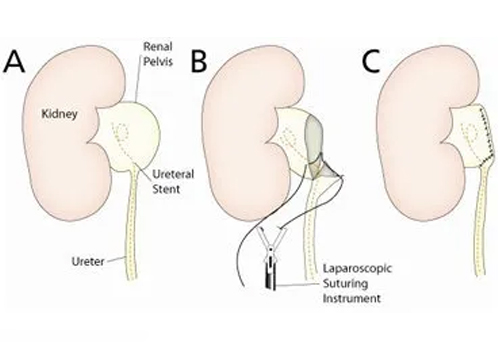
Laparoscopic pyeloplasty
Laparoscopic Pyeloplasty is a minimally invasive surgical procedure to correct ureteropelvic junction (UPJ) obstruction, which is a blockage where the kidney meets the ureter, impairing urine flow. This condition can lead to kidney swelling (hydronephrosis), pain, infections, or reduced kidney function. Laparoscopic pyeloplasty has largely replaced open pyeloplasty due to its lower invasiveness and faster recovery.
Indications
- Congenital or acquired UPJ obstruction causing:
- Persistent flank pain.
- Recurrent urinary tract infections.
- Hydronephrosis (detected on imaging).
- Decline in kidney function.
- Stones due to urine stasis.
Procedure
-
Anesthesia:
- Performed under general anesthesia.
-
Positioning:
- Patient is positioned on the side to allow optimal access to the kidney.
-
Trocar Placement:
- Small incisions are made to insert laparoscopic ports (keyhole incisions).
- A camera (laparoscope) and surgical instruments are introduced.
-
Exposure:
- The kidney and UPJ are identified.
- The obstructed portion of the UPJ is dissected and exposed.
-
Correction:
- The obstructed segment is excised.
- The ureter is reconnected to the renal pelvis (pyeloplasty) in a tension-free, watertight manner.
-
Stent Placement:
- A DJ (double-J) stent is placed temporarily to allow urine flow and healing.
-
Closure:
- The incisions are closed with sutures or surgical glue.
Techniques of Laparoscopic Pyeloplasty
- Anderson-Hynes Dismembered Pyeloplasty:
- Most common technique; involves cutting out the obstructed segment and reattaching the ureter to the renal pelvis.
- Y-V Plasty or Fenger Pyeloplasty:
- Used for less severe obstructions.
- The UPJ is reshaped without excision.
Advantages of Laparoscopic Pyeloplasty
- Minimally Invasive:
- Small incisions compared to open surgery.
- Faster Recovery:
- Shorter hospital stay (1–3 days) and faster return to normal activities.
- Reduced Pain:
- Less postoperative discomfort.
- Better Cosmesis:
- Minimal scarring.
- High Success Rates:
- Comparable to open pyeloplasty (90–95% success).
Disadvantages
- Requires advanced surgical expertise.
- Longer operative time compared to open surgery in some cases.
- Rare complications (see below).
Potential Risks and Complications
- Bleeding.
- Infection.
- Urine leakage at the repair site.
- Stent-related discomfort.
- Rare recurrence of UPJ obstruction.
Recovery
- Hospital Stay:
- Typically 1–3 days.
- Pain Management:
- Mild pain; managed with oral analgesics.
- Activity:
- Avoid strenuous activities for 4–6 weeks.
- Gradual return to daily activities.
- Hydration:
- Maintain good hydration to aid kidney function.
- Stent Removal:
- DJ stent is removed after 4–6 weeks (usually in an outpatient setting).
Follow-Up
- Imaging:
- Ultrasound or diuretic renogram (DTPA scan) to confirm unobstructed urine flow.
- Symptoms:
- Monitor for recurrence of pain, infection, or other symptoms.
Alternatives to Laparoscopic Pyeloplasty
- Endopyelotomy:
- Incision of the UPJ via an endoscope; less invasive but lower success rates.
- Robotic-Assisted Pyeloplasty:
- Offers greater precision and shorter recovery; performed using robotic systems.
- Open Pyeloplasty:
- Reserved for cases unsuitable for laparoscopy (e.g., complex anatomy, prior failed procedures).

